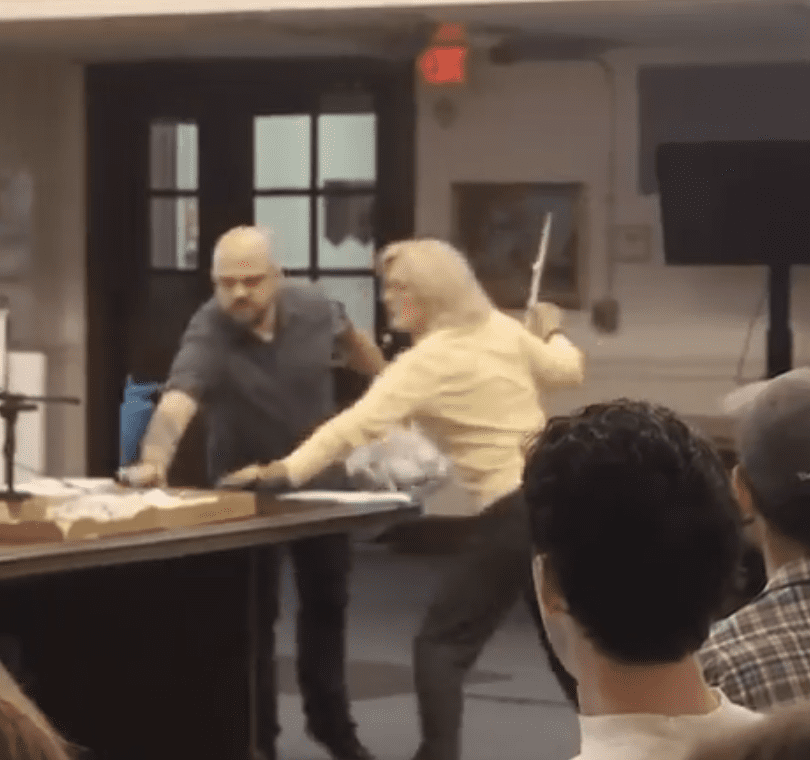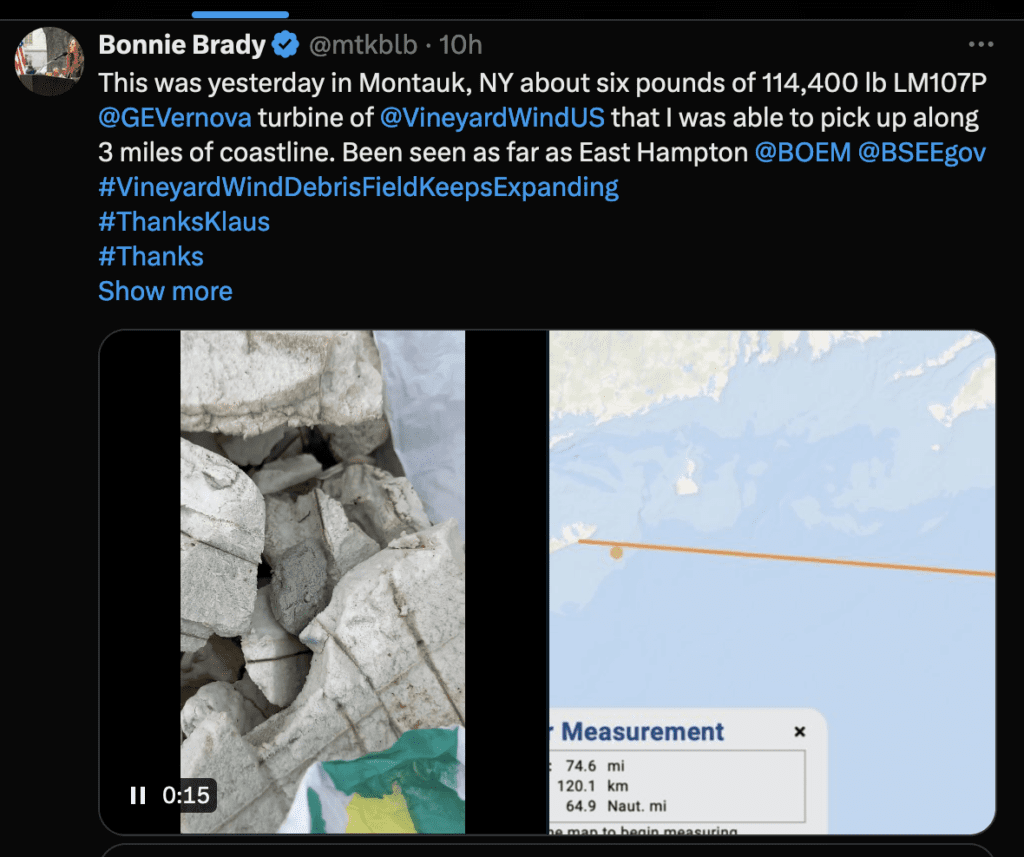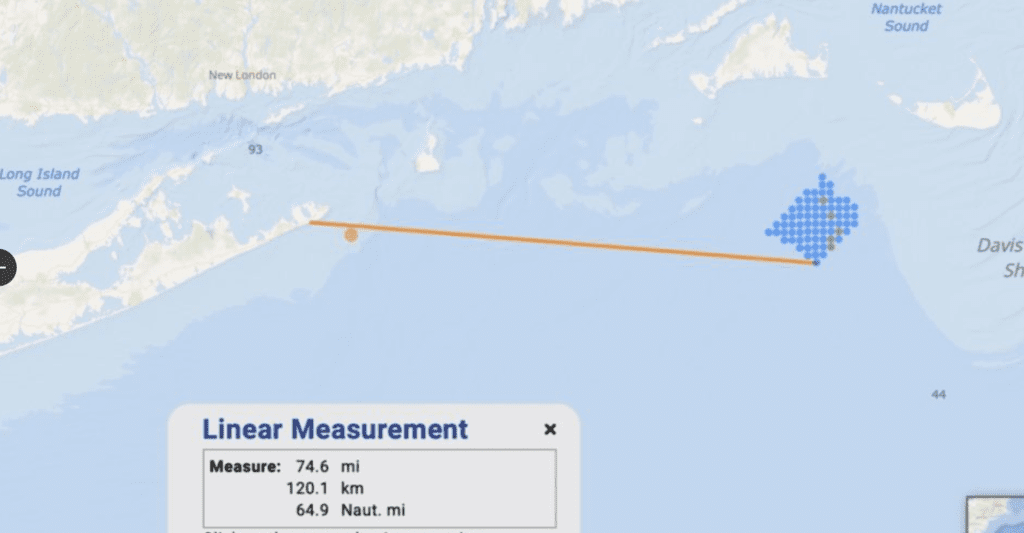Search Posts
Recent Posts
- Rhode Island Weather for May 21, 2025 – Jack Donnelly May 21, 2025
- Time for Sour Grapes! May 21st – Tim Jones May 21, 2025
- It is what it is: May 21, 2025 – Jen Brien May 21, 2025
- The RI Senior Games 2025 – “We need players!” May 21, 2025
- Another kerfuffle where strikers’ rights meet rights of children, elderly, homeowners, drivers May 21, 2025
Categories
Subscribe!
Thanks for subscribing! Please check your email for further instructions.

Tempers flare in Newport. Turbine debris found on Long Island. Vineyard Wind’s Suspension Order.
Photo from video by Newport, RI Police
As we follow the developments of the Vineyard Wind offshore turbine blade accident, we note the more and more frequent postings and photos of blade debris, not less, as time passes, being found on shores of Nantucket, Martha’s Vineyard, the Cape, Portsmouth RI, Tiverton, Little Compton, and now off Montauk Long Island.
Tempers are at a breaking point, as seen at a recent Newport City Hall meeting – the Newport Police are now trying to find the man in this video:
Off shore wind advocates really don't like it when you talk about the #vineyardwind blade failure. Newport RI Police posted this video today on Instagram of a 8/15 meeting at Newport City Hall. They are looking for the man, contact Detective Jack Billings at 401-845-5751.… pic.twitter.com/OWbP6Xg8Ye
— JohnFGately (@johnfgately) August 19, 2024
https://www.instagram.com/p/C-3C475hRcV (Newport Police Detectives need your help…if you recognize the individual in this video, please call Detective Jack Billings at 401-845-5751 or by email at [email protected]. This is in regard to an incident that occurred on 08/15/2024 during a public meeting at the Newport City Hall. Thank you for your assistance.)
___
In addition to drifting further from the original waters of Nantucket, the debris is now smaller in size, being pummeled by the ocean from big plank like pieces to shards, and now down to what looks like ground up glass, and in some cases mixing in with seaweed and other beach debris. This only shows what is happening on the shores. What is happening IN the water is unknown. The company reports the heavier portions of the blade are on the ocean floor. Are pieces being broken up into infinitismal pieces, and being eaten by fish and going into the human consumption circle? Unanswered questions.
The Bureau of Safety and Environmental Science has put a suspension order on business as usual at the site.
__
Bureau of Safety and Environmental Enforcement (BSEE) Issues New Order to Vineyard Wind in Continuing Investigation
The Bureau of Safety and Environmental Enforcement issued a new Suspension Order to Vineyard Wind 1 clarifying operational requirements and listing actions the company must take prior to personnel boarding any wind turbines.
The order continues to prohibit Vineyard Wind 1 from generating electricity from any of the facilities or building any additional wind turbine generator towers, nacelles, or blades. This order also requires Vineyard Wind 1 to submit to BSEE an analysis of the risk to personnel and mitigation measures developed prior to personnel boarding any facility. Vineyard Wind 1 is not restricted from performing other activities besides those specifically directed for suspension or additional analysis. For example, Vineyard Wind 1 is still permitted to install inter-array cables and conduct surveys outside of the damaged turbine’s safety exclusion zone.
“As our investigation continues, we are serving as a federal liaison between the responsible party, Vineyard Wind 1, GE Vernova, and other federal, state, local, and Tribal agencies,” said BSEE Director Kevin Sligh. “We are continuously engaged across all the incident response entities to ensure response operations are well coordinated and conducted safely through information sharing, planning and analysis of proposed activities.”
“BSEE prioritizes offshore worker safety and environmental protection, and we will use all tools available to ensure compliance with safety and environmental regulations on the Outer Continental Shelf,” said Director Sligh.
BSEE is conducting its own comprehensive and independent investigation into the causes and factors contributing to the incident and will evaluate all information provided to us. Those findings will be released to the public once our investigation is complete.
BSEE will continue to provide periodic updates here, as additional information is available. For information on the response and recover efforts, visit Vineyard Wind news and announcements.
___
In a recent SEC filing of GE Vernova, the Nantucket incident is written this way by the company:

Read the full report – HERE
___
Cautions from Vineyard Wind on handling debris:
From a statement by Vineyard Wind last week – “The U.S. Coast Guard maintains a 500-meter safety exclusion zone around the AW-38 turbine. Vineyard Wind and GE Vernova will continue utilizing a fleet of vessels, aerial surveys, and U.S. Coast Guard modeling to assess potential debris movement and deploy already mobilized resources as necessary to assist in the containment and collection of debris. Vineyard Wind remains under a federal preservation order to retain all debris and requests that only its employees, contractors, or those appointed by coordinating town officials handle and recover debris materials. Members of the public should avoid handling debris. Vineyard Wind will bag, track, and transport all debris to proper storage as soon as possible.”
___
What do the environmental groups and advocates say? Not much! But Nantucket has taken this on.
While the Nantucket Select Committee has published answers to several questions, including the ability to advocate both for clean energy like wind turbines – and the environment, the broader environmental groups have not weighed in much on what should happen with the wind farm. They published this statement: “The Town’s pro-clean energy and pro-heritage-preservation positions are not contradictory. We can pursue smart and timely renewable energy development at the same time we preserve what it means to live on and visit Nantucket. Nantucket is a National Historic Landmark like the Beacon Hill Historic District, Empire State Building, U.S. Capitol, and the White House. Nantucket’s modern economy and way of life are dependent on how people experience our historic buildings and landscapes and pristine ocean views. While everyone must be prepared to sacrifice to battle climate change, it is a false choice to say that the only way to timely pursue strategies for climate change is to sacrifice the character and economic sustainability of historic communities. If BOEM guts the provisions of these longstanding federal laws protecting culturally and environmentally significant places to facilitate expedient green energy projects, fossil fuel developers will exploit the bad precedent to undercut regulation of harmful projects for decades to come. Whatever gains society achieves through green energy development will soon be more than offset by the harms from less regulation of a far greater number of dirty energy projects. Nantucket has been warning the President’s Advisory Council on Historic Preservation about this concern for five years, through multiple administrations, regardless of the party in power.”
In an article last week in DailyCaller, the question was asked about the responses from the groups that promote wind energy. “Leading environmentalist organizations have offered inconsistent responses to a broken wind blade off the coast of Nantucket that has scattered debris into the ocean, with some staying entirely silent on the matter and others maintaining their support for offshore wind.”
They also noted that “…compared to other energy disasters in the ocean like oil spills, this incident is fairly contained and easily cleaned up to prioritize the safety of marine life,” Amber Hewett, the senior director of offshore wind energy for the National Wildlife Federation.“
And – “”The Sierra Club, another major eco-activism group, issued a statement on the Vineyard Wind situation on July 19, saying that it is “concerned about Vineyard Wind’s delay in providing notice to Nantucket officials and the public” about the damage, but emphasizing the importance of “[ensuring] that the failure of a single turbine blade does not adversely impact the emergence of offshore wind as a critical solution for reducing dependence on fossil fuels and addressing the climate crisis.”
___
Debris on the move
Reports of debris continue from Nantucket to the Cape, to Rhode Island, and the latest on the shores of Montauk, Long Island:

The map of Long Island and Nantucket route:

___
Disruption to whale and dolphins
According to “Stop These Things” dot com, “Offshore turbines also have their environmental problems, with disruption to whale and dolphin migrations during their construction. The subsequent sonic and subsonic vibrations are believed to cause disorientation and beaching events. Concerns have been raised around the world following unexplained whale deaths in the areas near wind farms, dividing environmental activists between those worried about the whales and others who continue to deny any connection to the nearby wind farms.” Hard data about the disruption is not readily available, but impacts on large ocean animals – and small – is, for the most part, unknown.
___
From The Nantucket Current:
by Jason Graziadei • Aug 13, 2024 – printed in cooperation with The Nantucket Current:
Vineyard Wind Allowed To Resume Some Construction Work As “Controlled Cutting” Of Blade Begins
The federal agency that suspended the Vineyard Wind project last month after its turbine blade failure is allowing the company to resume some construction activities even as it begins “controlled cutting” to remove the damaged blade.
While its investigation into the incident is not yet complete, the Bureau of Safety and Environmental Enforcement (BSEE) on Tuesday updated its suspension order for Vineyard Wind, allowing it to resume the installation of turbine towers and nacelles. The company is still prohibited from installing additional blades – all of which are in the process of being reinspected – or power production from the 24 turbines that have been completed since last October.
“The order continues to prohibit Vineyard Wind 1 from generating electricity from any of its wind turbine generators or installing blades on any turbine and requires risk analysis and mitigation approved by BSEE prior to being able to conduct any activities on the damaged turbine,” the agency said in a statement provided to the Current. “This new order acknowledges that Vineyard Wind 1 and GE Vernova have satisfied the safety and risk assessment conditions to continue activities other than blade installation and power production on other Vineyard Wind 1 WTGs, including resuming installation of towers and nacelles. Vineyard Wind 1 is also still permitted to install inter-array cables and conduct surveys outside of the damaged turbine’s safety exclusion zone.”
On Tuesday, the Foss Prevailing Wind barge departed from the Port of New Bedford carrying turbine components – including several tower sections and one nacelle – for transportation to the Vineyard Wind lease area. The barge was also carrying three of the 350-foot, 55-ton blades, but they will not be installed, Vineyard Wind stated. They remained on the barge “for the purpose of ensuring safe and balanced composition for the transport.” Following the installation of the turbine towers and nacelle, the blades will be returned to the New Bedford Marine Commerce Terminal.

News of the revised suspension order also comes on the same day Vineyard announced that it had begun “controlled cutting activities” on the damaged turbine blade 15 miles southwest of Nantucket. Those operations took place on Sunday, August 11, and Monday, August 12, and “removed a substantial amount of the remaining portions of the damaged blade that pose a risk for further debris falling into the ocean,” Vineyard Wind stated in a press release. As the cutting was taking place, Vineyard Wind and GE Vernova had maritime crews on several vessels around the turbine in an effort to recover as much debris as possible.
It was one of the first steps outlined in Vineyard Wind’s action plan released late last week to remove the remaining portions of the blade still hanging from the turbine.
The news regarding both developments – the revised suspension order and the “controlled cutting – was announced exactly one month to the day of the original turbine blade failure on July 13, and island residents continue to discover pieces of fiberglass and styrofoam from the blade on island beaches.
On Tuesday morning, Laurie Killen Patterson and Lauren Soverino both reported finding additional turbine blade debris at 40th Pole beach, along Nantucket’s north shore.



This article is from a continuing series about the impact of one fallen blade on one turbine off the coast of Nantucket.

Unfortunately, the panelist making the remark about “outburst” & “the meeting being setback” illustrates the “head-in-the-sand” position followed by alleged community leaders that have little concern for the actual impacts of offshore wind development.
For Pete sake, in 15 years we won’t know how we lived with out wind turbine it’s the learning curve right now. And why are you now trying to find out who this jack rabbit is? He was right there?
OWT are not green energy.Finally thousands of citizens are organizing to stop Atlantic Shores from constructing the 230 wind turbine disaster off the Jersey coast around Atlantic City by attending hearings, & funding lawsuits. Influenced by the Nantucket environmental disaster, and 18 months of public protests, this week the NJ Bureau of Public Utilities has canceled Orsted’s contract to build off Cape May.
The public must continue to demand the end of all OWT contracts. These international companies lied on their Environmental Impact Statement by never writing about the danger of breaking turbines.
Surely a crude oil disaster produces pollution. The difference is crude oil, while nasty and harmful, is a natural substance that integrates back into the ecosystem from which it came. Glass shards are not and will not degrade, they will always be present. A hurricane could destroy coastlines for human activity and shred tge gills of marine life for millenia. The Exon Valdeze, deep water horizon, completely dissolved by natural means. Not so with glass fibers.
The Rest of the Story:
Wind generator facts:
This web address is a picture of windmill blades eroding fiberglass particulates.
https://www.facebook.com/photo.php?fbid=10233470096439085&set=p.10233470096439085&type=3
https://www.facebook.com/photo/?fbid=398689343319003&set=a.106275769227030
Active
Donald Muckerheide
Top contributor
I am afraid folks are missing the big picture regarding fiberglass shards in the water. Windmill blades wear out. The reason blades wear out is the constant abrading of the leading edge of the blades. They are filled and repaired until the blade becomes beyond repair. This is a constant source of the finest and sharpest form of microplastics. This pollution is much like that of asbestos in that it never goes away.
The scale of this reality can be seen in photos of, and the conversation about, the massive areas of blades being buried in landfills where the bulldozer looks like an ant in comparison to the blades and landfill area.
For those who compare this issue to oil, they need to realize that oil is a natural substance that is consumed by aerobic microbes. It does ultimately go away or settle back into its natural environment. Even nuclear waste has a natural life cycle. This glass particulate does not – and will destroy the food chain on both farmland and the ocean.